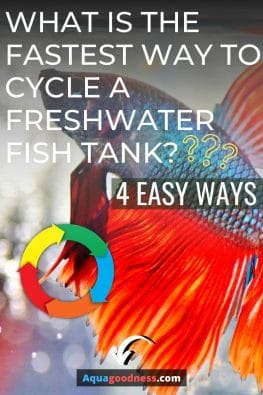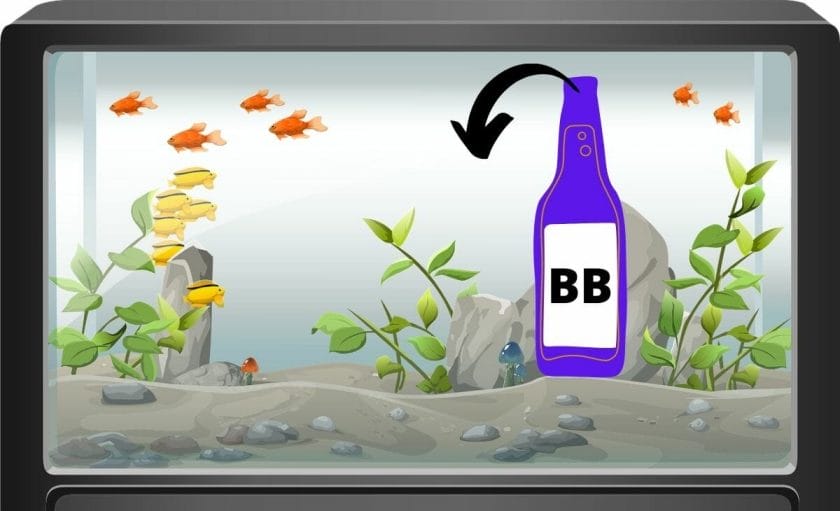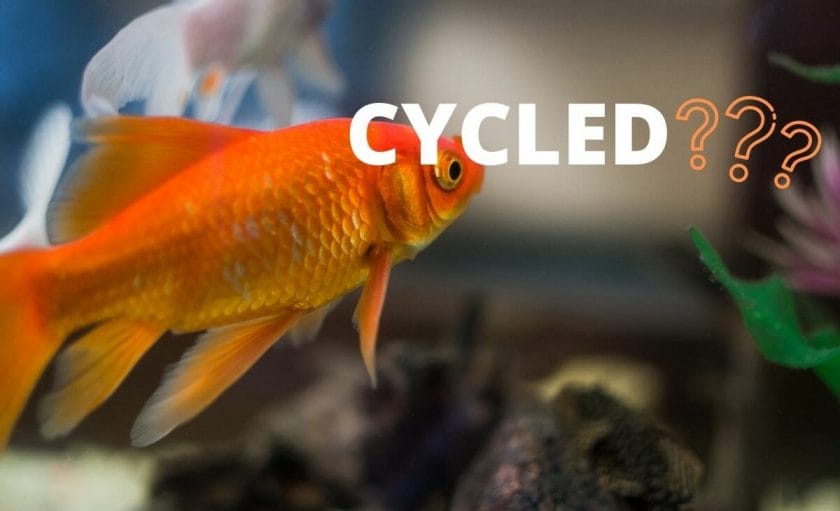If you want to know what is the fastest way to cycle a freshwater fish tank then you are in the right place.
In this article, I am going to share with you a few ways that you can use to instantly recycle your fish tank so won’t have to wait a month or so before adding fish in your tank.
Keep reading…
The fastest way to cycle your freshwater fish tank is using a filter or filter media from an already cycled tank or an established tank in your new tank.
Table of Contents
4 Ways to quickly cycle your freshwater fish tank

The whole point of cycling an aquarium is to have beneficial bacteria in your fish tank.
The beneficial bacteria break down the ammonia produced by fish waste into nitrite and nitrate.
This is important because ammonia is very harmful to fish.
Ideally. your fish tank should not contain any ammonia.
Even a slight ammonia level (up to 2 PPM) in your tank can lead to the death of the fish in your tank.
Likewise, nitrite is also harmful to fish.
Ideally, your fish time should not contain any nitrite.
When you have beneficial bacteria in your tank the ammonia is broken down into nitrite and then into nitrate.
Nitrate is far less harmful to the fish.
The fish in your tank will do just fine even when your tank has a high nitrate level (up to 50 PPM)!
However, the best practice is to keep it around 25 PPM.
Overall, when your tank has a sufficient amount of beneficial bacteria then you can conclude that your fish tank is cycled.
There are a few ways to directly and instantly introduce beneficial bacteria in your tank. So you don’t have to wait for the beneficial bacteria to populate in your tank naturally which can take a month or so.
52 Best Freshwater Aquarium Plants For Beginners
1. Use of filter from established or cycled freshwater fish tank
An aquarium filter not only filters the water in your aquarium but is also a great place for beneficial bacteria to create their colonies.
Specifically, the filter media of an established or cycled aquarium is packed with a lot of beneficial bacteria.
So if you already have an established tank then you can simply pull out the filter from the tank and put it in your new tank.
By doing so you are basically adding a ton of beneficial bacteria in your new tank and this will quickly cycle your tank.
And now you can add fish in your tank.
Do I Need Soil for Aquarium Plants?
2. Add filter media from a cycled or established tank in your new tank
As I mentioned earlier, the filter media is a great place for beneficial bacteria to form their colonies.
Specifically, the sponge filter of an established tank or cycled tank contains a lot of beneficial bacteria.
So if you just pull out the sponge from the filter of an established tank and put it in the filter of your new tank then basically you now have a ton of beneficial bacteria in your new setup.
This will instantly cycle your tank!
Do Aquarium Plants Grow Better in Sand or Gravel?
3. Add gravel from cycled or established tank in your tank
In an established tank, the beneficial bacteria not only grows in the filter media of the tank but is present throughout the tank.
It is present on the glass walls of the tank, on the ornaments of the tank, and on the substrate of the tank.
So if you can get a gravel substrate from an established tank and put it in your new tank then your tank will also have a lot of beneficial bacteria. Using this method your fish tank can get cycled in one day.
When to Plant Aquarium Plants? (and How to Plant Them)
But what if I don’t have an established tank or a cycled tank?
It is quite obvious, in this case, you will need to borrow it from someone who has an established or cycled tank.
1. Ask your friend
If you have a friend who is into the aquarium hobby and has some cycled tank or established tank then you can ask him for either filter of the established tank or the filter media of his established tank, specifically, the sponge from the filter of his/her established tank.
2. Ask your local fish store
Your local fish store will be very likely to help you and give you a filter media from one of their established tanks.
3. Ask someone from your local fish club
There are several local fish clubs in every country.
These are all the people who are into fishkeeping and they are very likely to help you get started in the hobby. And will most likely give you a filter media from their established tank.
Are Angelfish Good for Beginners?
Precautions to take while getting a filter media or filter from an established tank
When you add a filter media or filter from an established tank in your tank, you’re not only adding beneficial bacteria in your tank but you may also be adding any disease-causing bacteria or viruses in your tank.
That’s why it is very important that you should get the filter media or filter from a reputed source only.
Another thing is while bringing the sponge filter or the filter media to your place you don’t want it to get dry because this will kill the beneficial bacteria.
So pour down some water from the established tank into a plastic carry bag or any container and put the filter into the bag so it will not dry out.
Do Goldfish Like Plants in the Tank?
4. Add a bottle of bacteria into your tank

There are several brands that sell live beneficial bacteria in small bottles.
You just have to pour down the bottle in the water of your fish tank and now your tank has some beneficial bacteria in it.
Now you can add fish in your tank!
Some of my recommended beneficial bacteria bottles are as follows-
The problem with beneficial bacteria bottles
Beneficial bacteria are live organisms. And you’ll need to add only live beneficial bacteria in your tank so they can convert the ammonia into nitrite and then into nitrates.
Sometimes, the beneficial bacteria in the bottles die off and if you got such a bottle then basically it will not work out for you.
Some of my recommended beneficial bacteria bottles are as follows-
Most of the people had a good experience with these products-
- Dr.Tim’s Aquatics Freshwater One & Only Nitrifying Bacteria- See its reviews at Amazon here
- Fritz Aquatics FritzZyme 7 Nitrifying Bacteria for Fresh Water Aquariums- See its reviews at Amazon here
Tip: When you’re cycling your fish tank using any methods mentioned above, at the beginning stock your fish tank lightly. You should add a couple of small fish in the tank.
Just don’t add a lot of fish in the beginning!
After adding a couple of small fish keep testing the water for a couple of weeks for ammonia and nitrite spike. If you didn’t notice any ammonia or nitrite spikes then you can go ahead and add more fish in your tank.
6 Tips to Take Care of Live Plants in Aquarium (For Beginners)
How do I know when my tank is cycled?

When you add fish in your tank the fish produces waste which later gets converted into ammonia.
Ammonia is very harmful to the fish.
Ideally, your fish tank should not contain any ammonia.
If you have beneficial bacteria in your tank then this ammonia will break down into nitrites.
Just like ammonia, nitrite is also very harmful to the fish.
Ideally, your fish tank should not contain any nitrite.
Then the beneficial bacteria will convert nitrite into nitrates.
Now nitrates are far less harmful to the fish compared to ammonia and nitrites.
Most of the fish can tolerate nitrate levels as high as 40-50 PPM.
So you can say your fish tank is cycled i.e. it has completed the nitrogen cycle when after doing the test you noticed zero ammonia level, zero nitrite levels, and some nitrates level up to 50 PPM.
15 Mistakes Beginners Make with their Goldfish Tank (How to avoid them)
FAQ
How long does it take for a freshwater fish tank to cycle?
You can cycle your freshwater fish tank within a day and it can take as long as eight weeks to cycle.
Exactly how much time it will take really depends on what method you use to cycle your fish tank.
For example, if you add a filter or filter media from another established or cycled tank in your new tank then your fish tank will be cycled almost instantly or at least within 24 hours.
On the other hand, if you are using fish food to cycle your fish tank i.e. you are adding the fish food in your new tank. And then it is getting broken down into ammonia and then after a few weeks, the beneficial bacteria will convert ammonia into nitrite. And then after a couple of weeks, the nitrite will be converted into nitrates.
Then this whole process can take up to 6 weeks or even 8 weeks.
11 Things you can do TODAY to Keep your Goldfish Happy for Forever in your Aquarium
What happens if you don’t cycle your tank?
If you don’t cycle your tank before adding the fish then after adding the fish, the fish waste will produce ammonia in the tank.
In this case, as the fish tank doesn’t contain any beneficial bacteria to convert ammonia into nitrite and nitrate, the ammonia will build up in your tank.
A slight amount of ammonia even 2 PPM is deadly to the fish.
So if you don’t cycle a fish tank before adding the fish then the fish will eventually die.
Now there are some people who add the fish into the tank before cycling the tank.
In this case, the method they are using to cycle the fish tank is fish in cycling.
In this fish-in cycling, you use the fish waste produced by the fish as an ammonia source.
You’ll need to do partial water changes on a daily basis to keep the ammonia levels under control.
Eventually, the beneficial bacteria will start forming in the tank which will convert the ammonia into nitrite and then into nitrate.
Now his method of cycling can work and it has worked for a lot of people.
But it does stresses out the fish used in fish in cycling. Which can lead to diseases and shorten life expectancy in the fish.
Worst, if not done properly, the fish can die!
9 Must-haves for a Happy and Healthy Goldfish
How to cycle a tank without fish?
Cycling a fish tank without fish is a very natural way of cycling a tank.
And, in this method, you are not risking the life of the fish to cycle the tank.
To cycle a fish tank without fish you will need an ammonia source to get the cycle going and patience because it can take up to six weeks for the cycle to complete.
Ammonia source
There are two popular ammonia sources used for fishless cycling-
- The pure liquid ammonia
- Fish food
Cycling a tank with pure liquid ammonia as an ammonia source is very straightforward.
You just have to get the bottle of pure liquid ammonia and add a few drops in your tank.
Then test the water of your tank and see if it reaches 4-5 PPM of ammonia.
If it doesn’t then add a couple more ammonia drops in the tank and test the water again.
Repeat this until you see the ammonia levels in your tanks reach about 4 to 5 PPM.
On the other hand, if you are using fish food as an ammonia source then you will need to add about a pinch of fish food in your fish tank. And then wait for a couple of days and check the ammonia levels.
By this time you should see some ammonia levels.
If you found the ammonia levels are about 4-5 PPM then you don’t need to add more fish foo. But if the ammonia level is lower than 4-5 PPM then you will need to add about a pinch of fish food again in your tank. And then test the water again after a couple of days.
Once the ammonia reaches 4-5 PPM then you just have to wait and test the water regularly for ammonia levels and nitrite levels.
If the ammonia drops below 4 to 5 PPM then add ammonia in the tank.
Eventually, you will start noticing some nitrite levels.
And this is the point then you can conclude that your nitrogen cycle has started.
Now you just have to keep on testing the water for ammonia, nitrite, and nitrate. And maintain the ammonia levels of 4-5 PPM.
Then after a few days/weeks, you will start noticing some nitrate levels in your tank.
This is the sign that you are nitrogen cycle is progressing.
When you reach the point that after adding the ammonia in the tank the next day you noticed zero ammonia, zero nitrate levels, and some nitrate level in then you can conclude that your fish tank is cycled.
And now you can add fish in your tank!
What Can I Feed My Goldfish? (29 Fish Food Alternatives)
How to cycle a fish tank with Tetra safestart?
Follow the instruction below to properly cycle your fish tank using Tetra safestart.
- First of all, dechlorinate the water that you are going to add in your tank. You can easily do so using any water conditioner like Seachem prime. Check it out Amazon here.
- Now set up your fish tank- add substrate, ornaments, and filter in your tank.
- Now add the whole bottle of Tetra safestart in your tank.
- After adding the bottle add a small fish in your tank.
- Then add a pinch of fish food in your tank to feed the fish.
- Now you will need to test the water of your tank every day for ammonia, nitrite, and nitrate levels.
- If you noticed ammonia level then do a partial water change of about 20 to 30% of the water.
- While doing the water change make sure to dechlorinate the water before adding the water.
- Now you just have to continue this process i.e. testing the water of your tank every day and if you noticed ammonia and nitrite levels then doing a water change partial water change.
- When you get to the point when you start noticing zero ammonia, zero nitrite, and some nitrate level (ideal within 25 PPM) consistently then you can conclude that your fish tank is cycled properly.
What is the light in a fish tank for? (Do you really need it?)
How to cycle a fish tank in a week?
To cycle your fish tank within a week you can put the filter that you are going to use in your new tank set up in an established tank.
Within a week the filter media of the new tank will have a lot of beneficial bacteria populated all over it.
Now you just have to pull out the filter from the established tank and put it in your new tank. And now your new tank is cycled.
20 Tips to Maintain a Healthy Aquarium
Conclusion
Overall the fastest way to cycle a fish tank is by adding a filter or filter media from an established or cycled tank into your new tank.
By doing so, you are basically adding the beneficial bacteria in your tank.
The beneficial bacteria help to break down ammonia into nitrate which is far less harmful to the fish.
Or you can add a bottle of live beneficial bacteria in your new setup to instantly cycle your fish tank.
I hope you found this article helpful.
If you do, please share it.
And good luck with your nitrogen cycle!
Thanks Tom for this helpful article. We are going from a 2.5 gallon to a 35 gallon. Assuming the 35 gallon filter is too big to put on our established tank to quickly cycle our new tank, will adding the gravel from our established tank be enough to cycle the new tank? How long after adding the gravel from the established tank will it be safe to add our fish to the new tank? Thank you!!!
You could add the fish immediately after adding the gravel assuming the gravel has sufficient beneficial bacteria. One piece of advice I would like to give is you should add fish gradually in the new tank assuming you’re planning to add a lot more fish in the 35 g tank. Another trick you could do is you could add the sponge filter media from your established tank to the new tank to cycle it quickly.